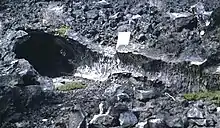Lava tree mold
A lava tree mold, sometimes erroneously called a lava tree cast, is a hollow lava formation that formed around a tree trunk. They are created when lava flows through an area of trees, coating their exterior. The lava cools just enough to create a solid crust around the trunk, but the tree inside burns away leaving a cavity.[1] Molds of trees may be vertical or horizontal.[2] In many cases, mold formation requires slow moving lava, as well as enough time for the mold to chill.[2]

Methane explosions
A unique phenomenon may occur during the formation of vertical tree molds. As the lava-encased tree burns away, the roots are heated up and generate a "producer" gas, such as methane. If the roots penetrate into a cavity, such as a lava tube or tumulus crack, it may come into contact with oxygen. Because there is a source of heat already present, the charred root or the lava itself, a methane explosion may follow if the oxygen and producer gas mixture is between 5 and 15% (volume-percent fuel).[3]
See also
References
- Charles Henry Hitchcock (1911). Hawaii and its volcanoes (second ed.). The Hawaiian Gazette Company. pp. 147–148.
rufus lyman.
- Green, Jack; Short, Nicholas M. (1971). Volcanic Landforms and Surface Features. p. 418.
- USGS (2002-10-17). ""Methane" explosions - a volcanic hazard worth understanding". USGS. Retrieved 2019-09-21.